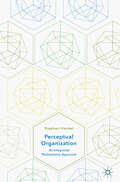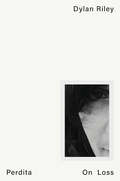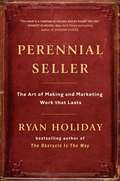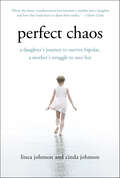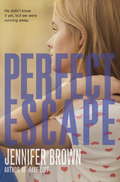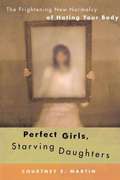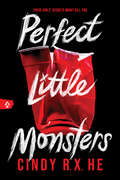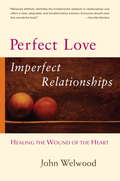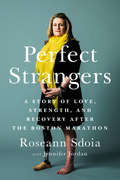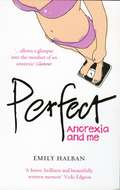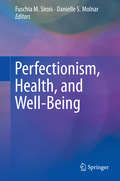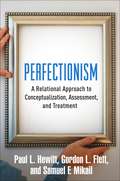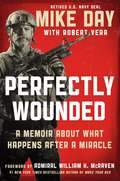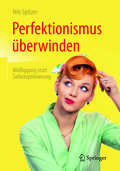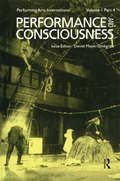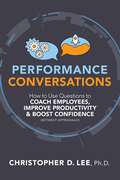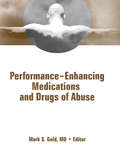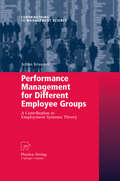- Table View
- List View
Perceptual Organization in Vision: Behavioral and Neural Perspectives (Carnegie Mellon Symposia on Cognition)
by Marlene Behrmann Ruth Kimchi Carl R. OlsonThis book presents an overview of different frameworks for understanding perceptual organization, and a state-of-the-art summary of the domain. It describes findings from visual search, illusory contours, and object recognition using electrophysiological measures.
Perceptual Organization: An Integrated Multisensory Approach
by Stephen HandelThis textbook goes beyond introductory sensory perception by incorporating supplementary electronic materials to demonstrate the parallels between both hearing and seeing. Each chapter intermixes seeing and hearing processes so that students can easily understand that perceptual organization is the same across different kinds of sensations and modalities. Figures illustrating visual organization are paired with sound files demonstrating the analogous auditory organization. While most books on sensation and/or perception treat the senses individually there is growing awareness of just how important multisensory integration is to understanding the connection between sensory perception and cognition.
Perceptual and Emotional Embodiment: Foundations of Embodied Cognition Volume 1
by Martin H. Fischer Yann CoelloThis two-volume set provides a comprehensive overview of the multidisciplinary field of Embodied Cognition. With contributions from internationally acknowledged researchers from a variety of fields, Foundations of Embodied Cognition reveals how intelligent behaviour emerges from the interplay between brain, body and environment. Covering early research and emerging trends in embodied cognition, Volume 1 Perceptual and Emotional Embodiment is divided into four distinct parts, bringing together a number of influential perspectives and new ideas. Part one opens the volume with an overview of theoretical perspectives and the neural basis of embodiment, before part two considers body representation and its links with action. Part three examines how actions constrain perception of the environment, and part four explores how emotions can be shaped and structured by the body and its activity. Building on the idea that knowledge acquisition, retention and retrieval are intimately interconnected with sensory and motor processes, Foundations of Embodied Cognition is a landmark publication in the field. It will be of great interest to researchers and advanced students from across the cognitive sciences, including those specialising in psychology, neuroscience, intelligent systems and robotics, philosophy, linguistics and anthropology.
Perdita: On Loss
by Dylan RileyAn intense literary memoir of love and grief&“Our marriage was, from any conventional point of view, wildly implausible; and you, my dear son, are the miraculous product of this beautiful, rather crazy, and all too brief love affair.&” When Dylan Riley received the devastating news that his wife, Emanuela, had cancer, he turned to writing to express the anguish and disarray brought by her worsening symptoms and then her passing. Perdita, composed for their teenage son, Eamon, is the result of this attempt to represent loss. It is at once a portrait of youth, a lyrical memoir of a marriage, and a raw and moving account of bereavement.Riley describes cancer, Perdita&’s central antagonist, as a pitiless opponent, draining hope of its power and reducing it to self-delusion. Its course forces a progressive foreshortening of time. Next year might be terrible, but there can be a few good months now; tomorrow will likely be bad, but let&’s focus on today.In this memoir, the disease provokes a broader set of reflections on the openness, contingency, and pain of the human condition, a status defined by the context of mortality, both our own and that of those we love.
Perennial Seller: The Art of Making and Marketing Work that Lasts
by Ryan HolidayHow did the movie The Shawshank Redemption fail at the box office but go on to gross more than $100 million as a cult classic? How did The 48 Laws of Power miss the bestseller lists for more than a decade and still sell more than a million copies?How is Iron Maiden still filling stadiums worldwide without radio or TV exposure forty years after the band was founded?Bestselling author and marketer Ryan Holiday calls such works and artists perennial sellers. How do they endure and thrive while most books, movies, songs, video games, and pieces of art disappear quickly after initial success? How can we create and market creative works that achieve longevity?Holiday explores this mystery by drawing on his extensive experience working with businesses and creators such as Google, American Apparel, and the author John Grisham, as well as his interviews with the minds behind some of the greatest perennial sellers of our time. His fascinating examples include:• Rick Rubin, producer for Adele, Jay-Z, and the Red Hot Chili Peppers, who teaches his artists to push past short-term thinking and root their work in long-term inspiration.• Tim Ferriss, whose books have sold millions of copies, in part because he rigorously tests every element of his work to see what generates the strongest response.• Seinfeld, which managed to capture both the essence of the nineties and timeless themes to become a modern classic.• Harper Lee, who transformed a muddled manuscript into To Kill a Mockingbird with the help of the right editor and feedback.• Winston Churchill, Stefan Zweig, and Lady Gaga, who each learned the essential tenets of building a platform of loyal, dedicated supporters.Holiday reveals that the key to success for many perennial sellers is that their creators don’t distinguish between the making and the marketing. The product’s purpose and audience are in the creator’s mind from day one. By thinking holistically about the relationship between their audience and their work, creators of all kinds improve the chances that their offerings will stand the test of time.
Perfect Chaos: A Daughter's Journey to Survive Bipolar, a Mother's Struggle to Save Her
by Linea Johnson Cinda JohnsonThe Johnsons were a close and loving family living in the Seattle area - two parents, two incomes, two bright and accomplished daughters. They led busy lives filled with music lessons, college preparation, career demands, and laughter around the dinner table. Then the younger daughter, Linea, started experiencing crippling bouts of suicidal depression. Multiple trips to the psych ward resulted in a diagnosis of bipolar disorder, and it took many trial runs of drugs and ultimately electroshock therapy to bring Linea back. But her family never gave up on her. And Linea never stopped trying to find her way back to them.Perfect Chaos is the story of a mother and daughter's journey through mental illness towards hope. From initial worrying symptoms to long sleepless nights to cross-country flights and the slow understanding and rebuilding of trust, Perfect Chaos tells Linea and Cinda's harrowing and inspiring story, of an illness that they conquer together every day. It is the story of a daughter's courage, a mother's faith, and the love that carried them through the darkest times.
Perfect Escape
by Jennifer BrownKendra has always felt overshadowed by her older brother, Grayson, whose OCD forces him to live a life of carefully coordinated routines. The only way Kendra can stand out next to Grayson is to be perfect, and she has perfection down to an art -- until a cheating scandal threatens her flawless reputation.Behind the wheel of her car, with Grayson asleep beside her, Kendra decides to drive away from it all -- with enough distance, maybe she'll be able to figure everything out. But even in the midst of the road trip's flat tires, gas-station food stops, and detours to quirky roadside attractions, eventually Kendra must stop running and come to terms with herself, her brother, and her past.With undeniable grace and humor, acclaimed author Jennifer Brown explores OCD, the pressure for perfection, and the emotional highs and lows of a complex sibling relationship.
Perfect Girls, Starving Daughters: The Frightening New Normalcy of Hating Your Body
by Courtney E. Martin"Why does every one of my friends have an eating disorder, or, at the very least, a screwed-up approach to food and fitness?" writes journalist Courtney E. Martin. The new world culture of eating disorders and food and body issues affects virtually all -- not just a rare few -- of today's young women. They are your sisters, friends, and colleagues -- a generation told that they could "be anything," who instead heard that they had to "be everything." Driven by a relentless quest for perfection, they are on the verge of a breakdown, exhausted from overexercising, binging, purging, and depriving themselves to attain an unhealthy ideal. An emerging new talent, Courtney E. Martin is the voice of a young generation so obsessed with being thin that their consciousness is always focused inward, to the detriment of their careers and relationships. Health and wellness, joy and love have come to seem ancillary compared to the desire for a perfect body. Even though eating disorders first became generally known about twenty-five years ago, they have burgeoned, worsened, become more difficult to treat and more fatal (50 percent of anorexics who do not respond to treatment die within ten years). Consider these statistics: Ten million Americans suffer from eating disorders. Seventy million people worldwide suffer from eating disorders. More than half of American women between the ages of eighteen and twenty-five would prefer to be run over by a truck or die young than be fat. More than two-thirds would rather be mean or stupid. Eating disorders have the highest mortality rate of any psychological disease. In Perfect Girls, Starving Daughters, Martin offers original research from the front lines of the eating disorders battlefield. Drawn from more than a hundred interviews with sufferers, psychologists, nutritionists, sociocultural experts, and others, her exposé reveals a new generation of "perfect girls" who are obsessive-compulsive, overachieving, and self-sacrificing in multiple -- and often dangerous -- new ways. Young women are "told over and over again," Martin notes, "that we can be anything. But in those affirmations, assurances, and assertions was a concealed pressure, an unintended message: You are special. You are worth something. But you need to be perfect to live up to that specialness." With its vivid and often heartbreaking personal stories, Perfect Girls, Starving Daughters has the power both to shock and to educate. It is a true call to action and cannot be missed.
Perfect Little Monsters
by Cindy R. HeSomeone has murdered the queen bee of Sierton High School. All the dead girl's friends are suspects. And each one has a reason for wanting her to die.Ella Moore was the most popular girl in school…and also the most hated. When she's murdered at her own party, there are too many suspects to count. And too many people who think she deserved it.The police's prime suspect is the new girl, Dawn Foster. Dawn was the last to hand Ella a drink on the night she died. Plus, all of Ella's friends with a motive for wanting Ella dead are more than willing to throw Dawn under the bus, if it means keeping the heat off themselves. But Dawn refuses to go down without a fight. She's determined to clear her name. As she delves deeper into the past, she discovers that Ella and her friends had major enemies, and someone is out for revenge. Dawn must uncover the truth before the police arrest the wrong suspect… and before the next person dies.
Perfect Love, Imperfect Relationships: Healing the Wound of the Heart
by John WelwoodWhile most of us have moments of loving freely and openly, it is often hard to sustain this where it matters most--in our intimate relationships. Why if love is so great and powerful are human relationships so challenging and difficult? If love is the source of happiness and joy, why is it so hard to open to it fully and let it govern our lives? In this book, John Welwood addresses these questions and shows us how to overcome the most fundamental obstacle that keeps us from experiencing love's full flowering in our lives.Perfect Love, Imperfect Relationships begins by showing how all our relational problems arise out of a universal, core wounding around love that affects not only our personal relationships but the quality of life in our world as a whole. This wounding shows up as a pervasive mood of unlove--a deep sense that we are not intrinsically lovable just as we are. And this shuts down our capacity to trust, so that even though we may hunger for love, we have difficulty opening to it and letting it circulate freely through us.This book takes the reader on a powerful journey of healing and transformation that involves learning to embrace our humanness and appreciate the imperfections of our relationships as trail-markers along the path to great love. It sets forth a process for releasing deep-seated grievances we hold against others for not loving us better and against ourselves for not being better loved. And it shows how our longing to be loved can magnetize the great love that will free us from looking to others to find ourselves.Written with penetrating realism and a fresh, lyrical style that honors the subtlety and richness of our relationship to love itself, this revolutionary book offers profound and practical guidance for healing our lives as well as our embattled world.
Perfect Strangers: Friendship, Strength, and Recovery After Boston's Worst Day
by Jennifer Jordan Roseann SdoiaFour lives brought together in a deadly moment prove that being in the wrong place at the worst time can lead to life's biggest adventures and most important relationshipsAs Roseann Sdoia waited to watch her friend cross the finish line of the Boston Marathon in 2013, she had no idea her life was about to change-that in a matter of minutes she would look up from the sidewalk, burned and deaf, staring at her detached foot, screaming for help amid the smoke and blood.In the chaos of the minutes that followed, three people would enter Roseann's life and change it forever. The first was Shores Salter, a college student who, when the bomb went off, instinctively ran into the smoke while his friends ran away. He found Roseann lying on the sidewalk and, using a belt as a tourniquet, literally saved her life that day. Then, Boston police officer Shana Cottone arrived on the scene and began screaming desperately at passing ambulances, all full, before finally commandeering an empty paddy wagon. Just then a giant appeared, in the form of Boston firefighter Mike Materia, who carefully lifted her into the fetid paddy wagon. He climbed in and held her burned hand all the way to the hospital. Since that day, he hasn't left her side, and today they are planning their life together.Perfect Strangers is about recovery, about choosing joy and human connection over anger and resentment, and most of all, it's about an unlikely but enduring friendship that grew out of the tragedy of Boston's worst day.
Perfect: Anorexia and Me
by Emily HalbanEmily Halban developed anorexia in her final year at school. She went on to university at Oxford where her disease took on a powerful dimension and by her final year she was so debilitated that she had to sit her exams in a separate room where she could be fed continuously.
Perfect: Anorexia and me
by Emily HalbanEmily Halban developed anorexia in her final year at school. She went on to university at Oxford where her disease took on a powerful dimension and by her final year she was so debilitated that she had to sit her exams in a separate room where she could be fed continuously throughout each one. With heartbreaking candour and poignant intimacy, Emily vividly chronicles the complexities and inner struggles of living with anorexia. Two years on, she traces her disease from its elusive origins, through its darkest moments of deprivation, guilt and self-loathing, and finally recounts her journey towards recovery. Emily allows us to understand what it's really like to suffer from anorexia, exposing its secrets and dispelling some of the myths that shroud it. Alive with self-awareness, but never self-pity, Perfect is an inspiring read that will help those battling with the horrors of anorexia find a way out, and those on the outside to understand more.
Perfecting Ourselves to Death: The Pursuit of Excellence and the Perils of Perfectionism
by Richard Winter<p>Perfect body. Perfect clothes. Perfect family. Perfect house. Perfect job. We strive for excellence in all areas of our lives. And there's nothing wrong with a healthy, mature pursuit of excellence. But what begins as healthy and normal can sometimes become neurotic and abnormal, leading to debilitating thoughts and behaviors: <p> <li>eating disorders <li>anxiety and depression <li>obsession and compulsions <li>fear of failure <li>relational dysfunction</li> <p>In Perfecting Ourselves to Death, Richard Winter explores the positive and negative effects of perfectionism on our lives. He looks at the seductive nature of perfectionism as it is reflected in today's media. He examines the price and perils of perfectionism. And he explores the roots of perfectionism, delving into what originally awakens this drive in us. After analyzing the negative feelings and defeatist behaviors that unhealthy perfectionism births, he provides practical strategies for how to change. "The important thing to see," writes Winter, "is that we are to strive to become better people, not just to be content with who we are or how we measure up to the standards of the culture around us." For Christians this means becoming more like Christ in every area of our lives. Here is the "perfect" book for those who struggle with perfectionism and for those pastors, counselors and friends who want to understand and help perfectionists.</p>
Perfection: A Memoir of Betrayal and Renewal
by Julie MetzJulie Metz's life changes forever on one ordinary January afternoon when her husband, Henry, collapses on the kitchen floor and dies in her arms. Suddenly, this mother of a six-year-old is the young widow in a bucolic small town. And this is only the beginning. Seven months after Henry's death, just when Julie thinks she is emerging from the worst of it, comes the rest of it: She discovers that what had appeared to be the reality of her marriage was but a half-truth. Henry had hidden another life from her."He loved you so much." That's what everyone keeps telling her. It's true that he loved Julie and their six-year-old daughter ebulliently and devotedly, but as she starts to pick up the pieces and rebuild her life without Henry in it, she learns that Henry had been unfaithful throughout their twelve years of marriage. The most damaging affair was ongoing--a tumultuous relationship that ended only with Henry's death.For Julie, the only thing to do was to get at the real truth--to strip away the veneer of "perfection" that was her life and confront each of the women beneath the veneer. Perfection is the story of Julie Metz's journey through chaos and transformation as she creates a different life for herself and her young daughter. It is the story of coming to terms with painful truths, of rebuilding both a life and an identity after betrayal and widowhood. It is a story of rebirth and happiness--if not perfection.
Perfectionism, Health, and Well-Being
by Fuschia M. Sirois Danielle S. MolnarThis book brings together the world's leading perfectionism researchers and theorists to present their latest findings and ideas on how and why perfectionism may confer risks or benefits for health and well-being, as well as the contexts which may shape these relationships. In addition to providing an overview of the latest research in this field, this volume explores new conceptual models that may help further our understanding of when, how, and why perfectionism may be implicated in health and well-being. After presenting an overview of the conceptual and measurement issues surrounding the concepts of perfectionism, health, and well-being, three sections address the implications of perfectionism for health and well-being. The first of these sections provides an overview of research and theory on the role of perfectionism in health and illness, health behaviors, and chronic illness. The next section of the book focuses on the cognitive and affective underpinnings of perfectionism as they relate to psychopathology, distress, and well-being, including how it applies to eating disorders, depression, and anxiety. The final section of the book explores specific contexts and how they may contour the associations of perfectionism with health and well-being, such as in the domains of interpersonal relationships, academic pursuits, and work-related settings. Perfectionism and wellbeing is a topic not just for researchers and scholars, but clinicians and practitioners as well. For this reason, chapters also include a discussion of prevention and treatment issues surrounding perfectionism where relevant. By doing so, this volume is an important resource for not only researchers, but also for those who may wish to use it in applied and clinical settings. By presenting the latest theory and research on perfectionism, health, and well-being with a translational focus, Perfectionism, Health, and Well-Being makes a unique and significant contribution to perfectionism as well as general wellness literature, and highlights the need to address the burden of perfectionism for health and well-being. .
Perfectionism: A Relational Approach to Conceptualization, Assessment, and Treatment
by Gordon L. Flett Paul L. Hewitt Samuel F. MikailGrounded in decades of influential research, this book thoroughly examines perfectionism: how it develops, its underlying mechanisms and psychological costs, and how to target it effectively in psychotherapy. The authors describe how perfectionistic tendencies--rooted in early relational and developmental experiences--make people vulnerable to a wide range of clinical problems. They present an integrative treatment approach and demonstrate ways to tailor interventions to the needs of individual clients. A group treatment model is also detailed. State-of-the-art assessment tools are discussed (and provided at the companion website). Throughout the book, vivid clinical illustrations make the core ideas and techniques concrete.
Perfectly Wounded: A Memoir About What Happens After a Miracle
by Mike DayThe incredible true story of former Navy SEAL Mike Day, who survived being shot twenty-seven times while deployed in Iraq.On the night of April 6, 2007, in Iraq's Anbar Province, Senior Chief Mike Day, his team of Navy SEALs, and a group of Iraqi scouts were on the hunt for a high-level al Qaeda cell. Day was the first to enter a 12x12 room where four terrorist leaders were waiting in ambush. When the gunfight was over, he took out all four terrorists in the room, but not before being shot twenty-seven times and hit with grenade shrapnel. Miraculously, Day cleared the rest of the house and rescued six women and children before walking out on his own to an awaiting helicopter, which flew him to safety.While in the hospital, the Navy SEAL lost fifty-five pounds in two weeks. It took almost two years for Day to physically recover from his injuries, although he still deals with pain. Like so many veterans, doctors diagnosed Day with Post Traumatic Stress Disorder and Traumatic Brain Injury -- the invisible wounds of war.Perfectly Wounded is the remarkable story of an American hero whose incredible survival defies explanation, and whose blessed life of service continues in the face of unimaginable odds. p.p1 {margin: 0.0px 0.0px 0.0px 0.0px; font: 12.0px Arial} p.p2 {margin: 0.0px 0.0px 0.0px 0.0px; text-indent: 36.0px; font: 12.0px Arial}
Perfektionismus überwinden
by Nils SpitzerDieses Buch zeigt, wie Optimierungszwang, Perfektionismus und Exzellenzstreben uns antreiben und belasten können – und es bietet ein Selbsthilfeprogramm, um einen belastenden Perfektionismus zu verändern, sowie Gegenbilder, wie wir uns aus der Leistungsfalle befreien können. Die Gesellschaft feiert Perfektionismus und Selbstoptimierung. Die Kehrseite: Die Reihe der psychischen Probleme, mit denen Perfektionismus in Zusammenhang gebracht wird, verlängert sich immer mehr: Erschöpfung und Aufschiebeverhalten, heftige Schamgefühle und Stress, Depression, Ess- und Zwangsstörung oder soziale Ängste ebenso wie Selbstmordgedanken, Grübeln und Burnout. Dieser Ratgeber zeigt Lösungswege, sich aus diesem Widerspruch des Perfektionismus – gewünschte Erfolgsorientierung und psychisch belastende Folgen – zu befreien. Geschrieben für Betroffene und Interessierte. Psychologische Psychotherapeuten, Psychiater, Psychotherapeuten und Berater können das Buch therapie- und beratungsbegleitend empfehlen.
Performance & Consciousness
by Daniel Meyer-DinkgräfeThis is volume 1, part 4 of the Performing Arts International forum. This collection of essays covers a breadth of topics on the theme of consciousness; addressing the trend of studies trying to put human experience into more concrete, cogent, less poetic and metaphorical terms. Major issues raised by the essays are summarised, and a hypothesis serving as a stimulus for further research and debate is suggested by the volume's conclusion.
Performance Autoethnography: Critical Pedagogy and the Politics of Culture
by Norman K. DenzinThis book is a manifesto. It is about rethinking performance autoethnography, about the formation of a critical performative cultural politics, about what happens when everything is already performative, when the dividing line between performativity and performance disappears. This is a book about the writing called autoethnography. It is also about what this form of writing means for writers who want to perform work that leads to social justice. Denzin’s goal is to take the reader through the history, major terms, forms, criticisms and issues confronting performance autoethnography and critical interpretive. To that end many of the chapters are written as performance texts, as ethnodramas. A single thesis organizes this book: the performance turn has been taken in the human disciplines and it must be taken seriously. Multiple informative performance models are discussed: Goffman’s dramaturgy; Turner’s performance anthropology; performance ethnographies by A. D. Smith, Conquergood, and Madison; Saldana’s ethnodramas; Schechter’s social theatre; Norris’s playacting; Boal’s theatre of the oppressed; and Freire’s pedagogies of the oppressed. They represent different ways of staging and hence performing ethnography, resistance and critical pedagogy. They represent different ways of "imagining, and inventing and hence performing alternative imaginaries, alternative counter-performances to war, violence, and the globalized corporate empire" (Schechner 2015). This book provides a systematic treatment of the origins, goals, concepts, genres, methods, aesthetics, ethics and truth conditions of critical performance autoethnography. Denzin uses the performance text as a vehicle for taking up the hard questions about reading, writing, performing and doing critical work that makes a difference.
Performance Conversations: How to Use Questions to Coach Employees, Improve Productivity, and Boost Confidence (Without Appraisals!)
by Christopher D. LeeThere are three universal truths about traditional performance management: they are widely used, universally despised, and are known to be ineffective. Performance Conversations offers a new model rooted in proven management science and tailored to today's workplace. Moving beyond ad hoc alternatives, this approach provides a unified framework for enhancing employee performance through continuous, manager-led practices. Like sliding the right key in a lock, performance conversations can open the door to unlimited possibilities. Dozens of ready-to-use templates and tools make the system practical, accessible, and easy to implement. Designed with today's workforce in mind, it aligns with the expectations of millennial and remote employees alike.Perfect for HR leaders and team managers, this guide delivers a smart, actionable solution for improving performance without the frustration of traditional reviews.
Performance Enhancing Medications and Drugs of Abuse
by Mark GoldPerformance Enhancing Medications and Drugs of Abuse explores various medications currently being abused by patients, from the drugs used for physical and cosmetic purposes by weekend warriors, professional athletes, and other at-risk populations, to the drugs used to enhance mood and memory.
Performance Evaluation and Benchmarking. Traditional - Big Data - Internet of Things
by Meikel Poess Raghunath NambiarThis book constitutes the thoroughly refereed post-conference proceedings of the 8th TPC Technology Conference, on Performance Evaluation and Benchmarking, TPCTC 2016, held in conjunction with the 41st International Conference on Very Large Databases (VLDB 2016) in New Delhi, India, in September 2016. The 9 papers presented were carefully reviewed and selected from 20 submissions. They reflect the rapid pace at which industry experts and researchers develop innovative techniques for evaluation, measurement and characterization of complex systems.
Performance Management for Different Employee Groups
by Achim KrausertManage managers based on competencies and informal networks - Set task-based output goals for professional specialists - Control temporary workers at the agency level - Ensure that contractors are managed effectively as part of boundary-crossing networks. This book provides a framework of analysis to capture and explain differences in employment systems. Taking account of the wealth of research in the field, it provides a sound basis for developing function-specific performance management systems, integrating aspects such as incentivization, multi-source appraisal, and accountability. From macro to micro approaches of HRM, the contents will be of value to researchers on employment systems, strategic HRM, and occupational psychology and to practitioners of HRM and organizational development. Achim Krausert has been a consultant in the performance management group of Accenture, U.K. He obtained his D.B.A. from the University of Mannheim, Germany, and an M.Sc. and a B.Sc. from the London School of Economics.

